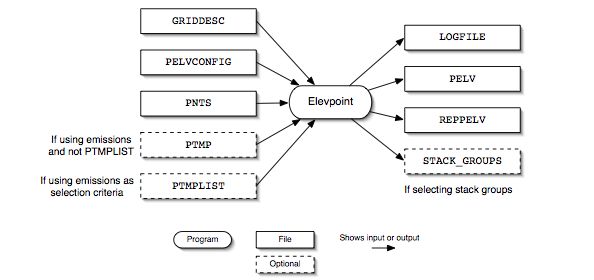Figure 6.3, “Elevpoint input and output files” shows the input and output files for the Elevpoint program. The input files are the grid description file (GRIDDESC), an elevated source configuration file (PELVCONFIG), the point-source inventory file output from Smkinven (PNTS), and, if the PELVCONFIG file selects sources by emissions value or rank, either a list of hourly emissions files output by Temporal (PTMPLIST) or an individual hourly emissions file (PTMP).
Elevpoint outputs a log file (LOGFILE), an elevated point source identification file (PELV), an elevated and PinG source report (REPPELV), and a stack parameters file (STACK_GROUPS) if the PELVCONFIG file is configured to select stack groups.
| File Name | Format | Description |
|---|---|---|
| GRIDDESC | ASCII | Description of the modeling grid |
| PELVCONFIG | ASCII | Elevated source configuration file |
| PNTS | SMOKE map | Intermediate inventory file produced by Smkinven |
| PTMP (optional) | ASCII | Hourly emissions file produced by Temporal; needed only when PELVCONFIG specifies emissions as one of the selection or grouping criteria and not using the PTMPLIST file |
| PTMPLIST (optional) | ASCII | List of hourly emissions files produced by Temporal; needed only when PELVCONFIG specifies emissions as one of the selection or grouping criteria |
-
G_RUNLEN: [default: 240000]
Simulation length (HHMMSS)
-
G_STDATE: [default: 0]
Starting date of simulation (YYYYDDD)
-
G_STTIME: [default: 0]
Starting time of simulation (HHMMSS)
-
G_TSTEP: [default: 10000]
Time step (HHMMSS), only 10000 is allowed
-
IOAPI_ISPH: [default: 8]
Determines which USGS spheroid to use for grid-based calculations
- 0: Clarke 1866
- 1: Clarke 1880
- 2: Bessel
- 3: New International 1967
- 4: International 1909
- 5: WGS 72
- 6: Everest
- 7: WGS 66
- 8: GRS 1980
- 9: Airy
- 10: Modified Everest
- 11: Modified Airy
- 12: WGS 84
- 13: Southeast Asia
- 14: Australian National
- 15: Krassovsky
- 16: Hough
- 17: Mercury 1960
- 18: Modified Mercury 1968
- 19: Normal Sphere
This environment variable can also be used to set custom spheroid representations. See the I/O API documentation for more information.
-
SMK_ELEV_METHOD: [default: 0]
Defines the method to use in SMOKE for determining and processing elevated point sources. The setting chosen depends on the model output format needed from SMOKE. All PinG sources determined based on SMK_PING_METHOD will automatically be considered elevated sources (as defined specifically for the model for which you are creating emissions).
-
0: Treat all sources as potentially elevated, and let the Laypoint program determine which sources are elevated and which are not. This approach is appropriate only for SMOKE output for the CMAQ and MAQSIP models.
-
1: Use the “Elevated” section of the PELVCONFIG configuration file to select specific sources. This approach can be used for any of the model output formats - CMAQ, MAQSIP, and UAM-style.
For UAM-style emissions processing, this environment variable must be set to 1 and the PELVCONFIG file will be used to select specific sources. This method of processing is needed for UAM, REMSAD, and CAMX because they require use of the cutoff method discussed earlier. In rare cases of a very small inventory, it might be acceptable to specify 0 for this setting in UAM-style emissions processing, provided that you are sure that treating all sources as elevated sources in UAM-style models is acceptable. We do not recommend such an approach for typical SMOKE applications for UAM-style models.
-
-
SMK_PING_METHOD: [default: 0]
Defines the method to use in determining PinG point sources.
-
0: No PinG sources
-
1: Use PinG section of PELVCONFIG configuration file
For all models that SMOKE supports except MAQSIP, use of PinG sources is optional. MAQSIP does not include a released PinG implementation. Some models may have limitations on the number of PinG sources supported, and you must make sure that these limitations are met; SMOKE does not automatically compare with these limitations, if any.
For CMAQ, SMOKE will output a STACK_GROUPS file from the Elevpoint program and a PINGTS_[S|L] file from the Smkmerge program to support PinG. For UAM-style processing, SMOKE will flag PinG sources in the ASCII elevated file created by Smkmerge, and should be used with the SMK_ASCIIELEV_YN option set to Y to create this ASCII elevated file.
-
-
SMK_SOURCE: See description in Section 6.2.3.2, “Input Environment Variables”
| File Name | Format | Description |
|---|---|---|
| LOGFILE | ASCII | Log generated from executing Elevpoint |
| PELV | ASCII | Elevated point source identification file |
| REPPELV | ASCII | Reports the sources selected as elevated and PinG, plus other information about the sources, including why they were selected |
| STACK_GROUPS | I/O API NetCDF | PinG and/or elevated sources stack parameters file |
